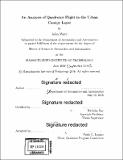| dc.contributor.advisor | Nicholas Roy. | en_US |
| dc.contributor.author | Ware, John (John Welling) | en_US |
| dc.contributor.other | Massachusetts Institute of Technology. Department of Aeronautics and Astronautics. | en_US |
| dc.date.accessioned | 2017-02-22T19:01:28Z | |
| dc.date.available | 2017-02-22T19:01:28Z | |
| dc.date.copyright | 2016 | en_US |
| dc.date.issued | 2016 | en_US |
| dc.identifier.uri | http://hdl.handle.net/1721.1/107056 | |
| dc.description | Thesis: S.M., Massachusetts Institute of Technology, Department of Aeronautics and Astronautics, 2016. | en_US |
| dc.description | Cataloged from PDF version of thesis. | en_US |
| dc.description | Includes bibliographical references (pages 105-113). | en_US |
| dc.description.abstract | This thesis presents two distinct bodies of work concerning quadrotor flight in urban wind fields. The first attempts to characterize a quadrotor's ability to exploit urban wind fields for improved flight performance. A computational fluid dynamics model is used to obtain a wind field estimate given a 3D model of the environment and a prevailing wind estimate. Minimum-energy trajectories are then found through the environment using an empirically derived power consumption model for a specific quadrotor platform. It is shown in simulation that a minimum-energy planner aware of the wind field outperforms a naive, wind-unaware planner over metrics such as total energy consumption, time to goal, and failure rate. The second component of the work focuses on the development of an onboard wind sensor for quadrotors. Although it is not yet clear how to integrate these measurements into a global wind field estimate or use them in a planner, it is intuitive that on-board measurements could inform the local wind field estimate or validate the global one. Accordingly, an effort was made to integrate an existing microelectromechanical flow sensor into a quadrotor platform. Initial results from full-scale tests in the Wright Brothers wind tunnel at MIT demonstrate the the sensor's performance in flight and hover conditions. | en_US |
| dc.description.statementofresponsibility | by John Ware. | en_US |
| dc.format.extent | 113 pages | en_US |
| dc.language.iso | eng | en_US |
| dc.publisher | Massachusetts Institute of Technology | en_US |
| dc.rights | MIT theses are protected by copyright. They may be viewed, downloaded, or printed from this source but further reproduction or distribution in any format is prohibited without written permission. | en_US |
| dc.rights.uri | http://dspace.mit.edu/handle/1721.1/7582 | en_US |
| dc.subject | Aeronautics and Astronautics. | en_US |
| dc.title | An analysis of quadrotor flight in the urban canopy layer | en_US |
| dc.type | Thesis | en_US |
| dc.description.degree | S.M. | en_US |
| dc.contributor.department | Massachusetts Institute of Technology. Department of Aeronautics and Astronautics | |
| dc.identifier.oclc | 971022922 | en_US |
